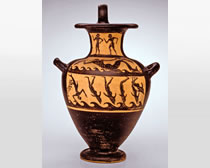Archived Content
In an effort to keep ICE.gov current, the archive contains content from a previous administration or is otherwise outdated. This information is archived and not reflective of current practice.
Agreement paves way for artifact's return to Italy
CLEVELAND – A rare Etruscan black-figure kalpis which has been traced back to 510 B.C. will be returned to the Italian government following an agreement between the United States and the Toledo Museum of Art. The arrangement comes after an extensive investigation by U.S. Immigration and Customs Enforcement's (ICE) Homeland Security Investigations (HSI).
The kalpis, a ceramic vessel used in ancient times for holding water, depicts a mythological scene of pirates being transformed into dolphins by Dionysos. It was smuggled out of Italy after an illegal excavation prior to 1981. It was then sold in 1982 to the Toledo Museum of Art by art dealers Gianfranco and Ursula Becchina, who had earlier purchased it from convicted art smuggler Giacomo Medici. The Becchinas misrepresented the true provenance of the vase to the museum by providing falsified documentation.
Following a January 2010 lead from HSI's Rome attaché, Cleveland-based HSI special agents launched an investigation into the true provenance of the artifact. Working closely with law enforcement officials in Italy, HSI special agents were able to definitively establish that the documentation provided to the Toledo Museum of Art was falsified and part of a larger scheme by the Becchinas to sell illegitimately obtained cultural property. Gianfranco Becchina was convicted in February 2011 of illicitly dealing in antiquities by a court in Rome. That conviction was appealed by Becchina and remains in the Italian court system.
According to court documents, the kalpis has been valued at more than $665,000.
"This agreement establishes the true provenance of the kalpis and reconnects this valuable artifact to its rightful cultural origin and history," said Brian M. Moskowitz, special agent in charge of HSI Michigan and Ohio. "We applaud the integrity of the Toledo Museum of Art for their willingness to ensure that this piece is repatriated to its home country."
"This is an example of our office, ICE HSI and the Toledo Museum of Art working collaboratively to return this artifact to its rightful place," said Steven M. Dettelbach, U.S. Attorney for the Northern District of Ohio. "A cultural artifact such as this has value beyond its price tag and we are proud that it will be returned to Italy later this year."
The kalpis will be formally repatriated in an official ceremony later this year with the Toledo Museum of Art, HSI, federal prosecutors and representatives from the Italian government.
HSI plays a leading role in criminal investigations that involve the unauthorized importation and distribution of cultural property, as well as the illegal trafficking of artwork. It specializes in recovering works that have been reported lost or stolen. The HSI Office of International Affairs, through its 70 attaché offices in 47 countries, works closely with foreign governments to conduct joint investigations, when possible.
HSI specially trained investigators, assigned to both domestic and international offices, partner with governments, agencies and experts to protect cultural antiquities. They also train investigators from other nations and agencies on investigating crimes involving stolen property and art, and how to best enforce the law to recover these items when they emerge in the marketplace.
Since 2007, HSI has repatriated more than 2,500 items to more than 23 countries.
Learn more about HSI cultural property, art and antiquities investigations.


